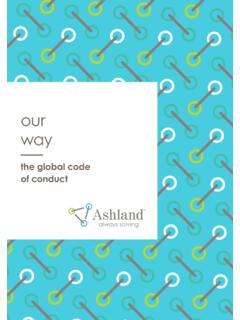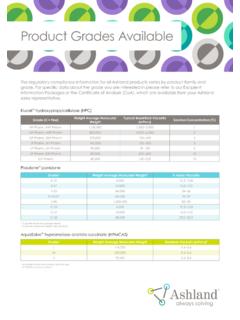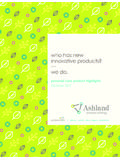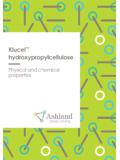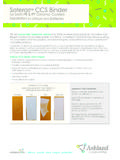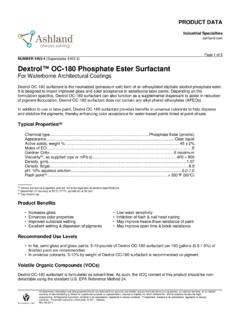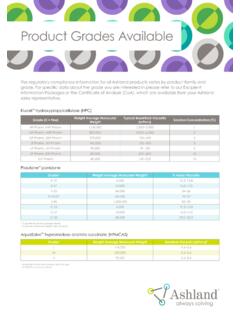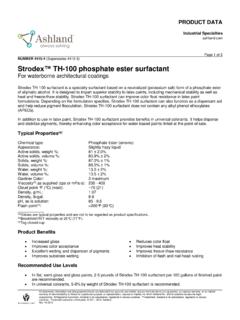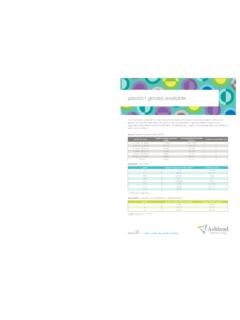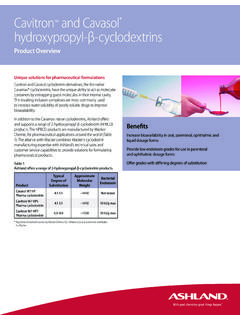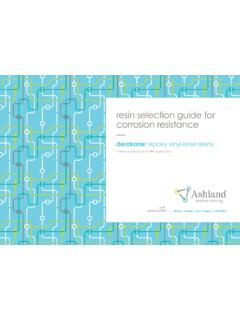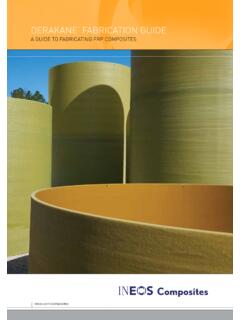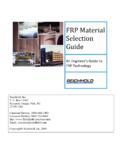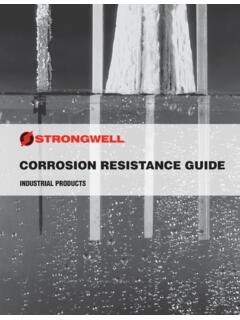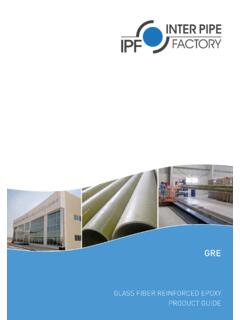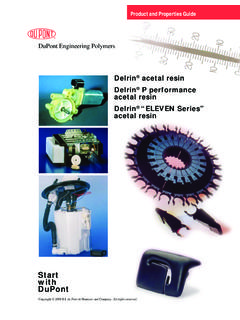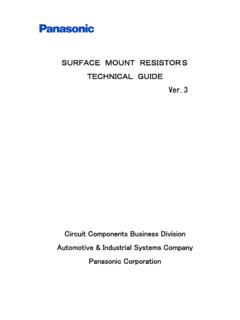Transcription of Derakane epoxy vinyl ester resins chemical resistance guide
1 Derakane epoxy vinyl ester resins chemical resistance guide Resin selection guide for corrosion resistant FRP applicationsEnglish Foreword 4 Brief Product Description 5 How to Use the chemical resistance Table 6 Special Cases 9 Mixtures of Alternating Environment 10 Derakane epoxy vinyl ester resins - Special resistance Enquiry Form 11 French Avant-propos 12 Br ve description des produits 13 Comment se servir de la table de r sistance chimique 14 Cas sp ciaux 17 M langes de produits ou expositions altern es diff rents environnements 18 Derakane epoxy vinyl ester resins - Demande de Resitance Chimique 19 German Vorwort 20 Kurzbeschreibung der Harze 21 Anleitung zur Benutzung dieser Brosch re 22 Spezialf lle 25 Mischmedien oder Wechselbeanspruchung 26 Derakane epoxy vinyl ester resins - Vordruck f r Best ndigkeitsangragen 27 Derakane chemical resistance GuideTable of Contents2 Portuguese Pref cio 28 Breve Descri o do Produto 29 Como Utilizar a Tabela de Resist ncia Qu mica 30 Casos Especiais 33 Misturas ou Ambientes Alternados 34 Resinas Ep xi ster Vin licas Derakane - Formul rio Para Consulta Sobre Resist ncia Qu mica 35 Spanish Pr logo 36 Breve Descripci n de los Productos 37 C mo utilizar la Tabla de Resistencia Qu mica 38 Casos Espec ficos 41 Mezclas de Productos o Exposiciones alternadas a diferentes Medios 42 Derakane Resinas Epoxi Vinil ster - Solicitud de Resistencia Qu mica 43 chemical Name/CAS Numbers 44 chemical resistance Table.
2 Maximum Service Temperatures for Derakane and Derakane Momentum resins 46-68 Derakane chemical resistance GuideTable of Contents3 Derakane and Derakane Momentum epoxy vinyl ester resins are designed and manufactured by Ashland. These resins possess outstanding corrosion -resistant properties and satisfy critical requirements in Fiber-Reinforced Plastic (FRP). Because they possess outstanding corrosion -resistant properties Derakane and Derakane Momentum resins are particularly well suited for tough industrial guide briefly describes the various Derakane and Derakane Momentum resins , and it presents detailed chemical resistance data needed to assist engineers in specifying and designing corrosion -resistant FRP given in this guide apply to state-of-the-art corrosion -resistant structures.
3 Typically these structures have a corrosion barrier that is to mm (100 to 250 mils) thick and are designed for contact with a specific chemical environment. The first layer of the corrosion barrier usually is to mm (10 to 20 mils) thick and is 95% resin, reinforced by one or two surfacing veils. This layer is then backed with 2 to 6 mm (90 to 230 mils) of 75% resin, reinforced with chopped strand mat (powder binder only). Finally, the corrosion barrier is backed with a structural laminate that provides the strength and stiffness of the overall corrosion -resistant composite structure. Because many of the variables that affect the performance of a laminate are beyond Ashland s control, no warranty concerning the use of Derakane and Derakane Momentum epoxy vinyl ester resins can be made. However, the service conditions shown in this bulletin are believed to be well within the capabilities of Derakane epoxy vinyl ester resins when laminates are properly designed, fabricated, and the design of FRP equipment, prospective users of Derakane resins should refer to the appropriate industry standards and design more information, contact Ashland at or visit chemical resistance GuideEnglish4 Brief Product DescriptionDerakane and Derakane Momentum 411 resins are the globally recognized standard for epoxy vinyl ester resins .
4 They are based on bisphenol-A epoxy resin, and they provide resistance to a wide range of acids, alkalis, bleaches and solvents for use in many chemical processing applications. They offer excellent toughness and fatigue and Derakane Momentum 441-400 resins are low styrene monomer bisphenol-A epoxy vinyl ester resins with mechanical, thermal and chemical resistance properties between Derakane 411 and Derakane 470 resins . Their unique combination of high HDT and elongation makes them resins of choice for applications with thermal cycling, , for chemical reaction and Derakane Momentum 470 resins are epoxy novolac-based vinyl ester resins designed to provide exceptional thermal and chemical resistance properties. They offer high resistance to solvents, acids and oxidizing substances such as chlorine. They also offer high retention of strength and toughness at elevated temperatures, making them the resins of choice for flue gas and Derakane Momentum 510A/C resins are brominated epoxy vinyl ester resins that offer a high degree of fire retardance1.
5 They are very resistant to chemical attack by chlorine and bleach environments. Their bromine content makes them tougher and more fatigue resistant than standard epoxy vinyl ester 510N resin is brominated epoxy novolac vinyl ester resin that offers a moderate degree of fire retardance1. It exhibits a corrosion resistance similar to Derakane 470 resins in most environments. It is also useful in hot, wet fluegas environments where thermal upsets can occur and where fire retardance is desired. This product is only available in North America. Derakane 8084 resin is an elastomer-modified bisphenol-A epoxy vinyl ester resin that offers very high toughness, impact- and fatigue- resistance , and excellent adhesion. It is the resin of choice for demanding structural applications and as a primer for chemically resistant FRP The degree of retardance achieved in properly formulated cured products made of these resins is most frequently quantified by the ASTM E84 tunnel test.
6 This is a controlled test that compares flammability characteristics of one material with another, but may not be predictive of behavior in a real fire situation. Derakane and Derakane Momentum epoxy vinyl ester resins are organic materials and will burn under the right conditions of heat and oxygen chemical resistance GuideEnglish5 ContentThis listing of chemical reagents and environments shows the highest known temperature at which equipment made with Derakane and Derakane Momentum resins has, in general, either: given good service in industry or been tested in the field or in the laboratory (in accordance with ASTM C 581) with results that indicate a good life expectancy in should be noted that this is not necessarily the maximum service temperature limits in each row are representative of the whole series of resins ( , Derakane 411 resin applies to 411-350, 411-45, 411C-50, etc.)
7 And their Derakane Momentum counterparts. The following table lists the resins that are included in the respective to Use the chemical resistance TableDerakane chemical resistance GuideEnglishColumns411 series441 series470 series510N series510A/C seriesValid for 411-350441-400470-300510N510A-40 Derakane resins053-C015S03-07454-114470-36470-36S 470-45470 HTValid for 350-C015003-074002-114 Derakane MOMENTUM resins053-114 Table 16 Derakane chemical resistance GuideEnglishIn the chemical resistance tables, a blank space simply indicates that no data was available at the time that temperature ratings were stands for not recommended at any stands for limited service (at least 3 days to 1 year at maximum 40 C/100 F). Generally in these cases, the respective resins can be used for FRP that is exposed accidentally, and where cleaning and inspection are possible after no more than 3 guide is updated on a regular basis in order to take into consider-ation all the new experiences and data (new products, other tempera-tures or concentrations, etc.)
8 Derakane ResinChemical EnvironmentConcentration %411441470510A/C510N8084 Hydrochloric Acid &Dissolved Organics8,9,130 - 33% HClNR65/15015 NRExample8 Double surfacing veil and a 5 mm/200 milCR barrier should be used9 Double C-veil should be used in the CR resistant glass should be used in thecorrosion liner and may be used in the structural wallweight - % (unless otherwise stated) not recommendedno dataavailablehighest recommendedtemperature( C/ F) 15 Slight discoloration ofhigh purity acidcan occur during rst exposures7 FootnotesInformation indicated in footnotes is essential in order to ensure a good service life of FRP equipment. It is strongly recommended that they are Double synthetic veil should be used in the chemical Resistant (CR) Post cure recommended to maximize service Benzoyl Peroxide/Amine cure system recommended to increase service Recommended provided that solvent used for dissolution is also Satisfactory up to maximum stable temperature for Check with corrosion technical service lab for specific Probably satisfactory at higher temperatures, but temperature shown is the highest for which information was Double surfacing veil and a minimum of 5mm/200mil CR barrier should be used9.
9 Double C-veil should be used in the CR For reactors, use 441, 411, or 510A/C resins11. Within the solubility limits in aqueous Above 50 C/120 F, acid resistant glass should be used in the CR barrier and may be used in the structural Acid resistant glass should be used in the corrosion liner and may be used in the structural If chemical composition is unknown, obtain Safety Data Sheet from supplier15. Slight discolouration of high purity acid can occur during first exposures, please contact the technical service, for futher explanations. 16. The use of the resin above the maximum allowable design temperature as limited by national design standards may require approval of the relevant The service life is proportional to CR barrier thickness. 18. For food contact applications, local regulations take priority.
10 Please see our Fabricating Tips guide or contact the Technical Service team, 19. Preference for Derakane 510A-40 : Not RecommendedLS: Limited service, in general 3 days to 1 year lifetime at room temperature (max. 40 C/100 F), usually sufficient for secondary a service temperature below 100 C/210 F: A postcure may extend the service life if the operating temperature is within 20 C/40 F of the present CR guide maximum temperature for the service. This means that a postcure can be beneficial for solvent applications with a temperature limit of 25-40 C/80-100 a service temperature above 100 C/210 F: Postcure in service may be sufficient, provided the resin specific minimum Barcol hardness values are reached before start service in pure and neutral salt solutions: Postcure may, in general, not be required, provided the resin specific minimum Barcol hardness values are reached and no acetone sensibility is shown before start using a BPO/Amine cure system, postcure is strongly recommended and should be done within two weeks of postcure conditions as detailed in DIN 18820 may be used: For 411, 441, 510A/C and 8084 resins : 80 C/180 F.
